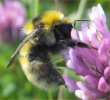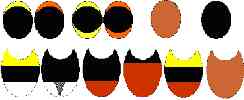|
There are about 19
different species of bumblebee (and six species of
cuckoo bumblebees)
found in the UK, 66 in Europe and around 250 in the world.
Is It A
Bumblebee?
Discover The Bumblebee
Cuckoo
Bumblebees
Other
Bees
A note on the
identification of Bombus muscorum and
B. pascuorum
The two brown carder bees
we have in Scotland are the two most difficult Bombus to distinguish in
the field, and are almost as difficult to separate in the hand. In part
this stems from the fact that the distinction given in Alford’s keys and
in all published keys since (presence or absence of black hairs on the
abdomen) is unreliable, at least in Scotland.
Known distribution:
B. pascuorum is common over all of Scotland except for Shetland, the
Western Isles, some of the Orkney islands, and some of the Inner Hebrides.
B. muscorum is the only one to occur on the Western Isles and Shetland (as
distinctive races), and is found in Orkney, many of the Inner Hebrides,
and sparingly on the mainland where it is rare. Where they occur together,
the two species will forage in the same place. B. muscorum will more
frequently be found on heather moor than pascuorum. The initial
supposition should be that on the mainland any brown carder bee is
pascuorum, except on the north and west coasts or in the hills. Except on
Shetland and the Western Isles, care must be taken to establish which of
the two species is present before it is recorded definitively. For the
HBRG Atlas scheme I have asked that a specimen is provided for any record
of muscorum.
Identification:
Both species are essentially all brown, the thorax usually being
(sometimes strongly) foxy red and the abdomen paler. There is no
consistent difference between the thorax colour of the two species on the
mainland, though the island muscorum are very disctinctively dark on the
thorax. On average, queen muscorum are probably slightly larger than
pascuorum, but size is not a reliable character.
Observations of specimens
from the mainland and Orkney by John Crossley and myself have established
that some muscorum do have black hairs on the abdomen, while some
pascuorum do not have any that are visible even under the binocular
microscope. This character, the favoured one in published keys, is
therefore not reliable, though any specimen with plentiful black hairs on
the sides of the abdomen will be pascuorum.
The only reliable
objective distinction is in the genitalia of the male and sting sheath of
the female. It is therefore important that specimens sent for confirmation
have these parts exposed. Unfortunately, examination of the genitalia is
usually, and of the sting sheath always, fatal for the bee, so it is not
to be used too freely.
I have established that,
with practice, it is possible confidently to distinguish the species in
the field by the colour of the abdomen. B. muscorum (both sexes) has a
distinctly silvery wash on the abdomen, which is very obvious when one
knows what to look for, and is very different from the buff or brown wash
of pascuorum. Even this is not to be used on occasional bleached and worn
individuals. Curiously, this is not nearly as easy to see in museum
specimens, possibly in part due to fading after death.
For field recognition, it
should be obvious if two species of carder are present together, and a
specimen of each type (silvery and brown wash) taken for confirmation. If
only one appears to be present, then only one specimen need be provided if
the species is uncertain. It is important not to make definitive
identifications on probability alone.
Murdo Macdonald
Common names of the
Bumblebees of northern Scotland
|
Latin |
English |
|
|
|
|
B. soroeensis |
Broken-belted
Bumblebee |
|
B. lucorum |
White-tailed
Bumblebee |
|
B. magnus |
Northern
White-tailed Bumblebee |
|
B. terrestris |
Buff-tailed
Bumblebee |
|
B. jonellus |
Heath Bumblebee |
|
B. monticola |
Bilberry Bumblebee |
|
B. pratorum |
Early Bumblebee |
|
B. lapidarius |
Red-tailed Bumblebee |
|
B. hortorum |
Garden Bumblebee |
|
B. muscorum |
Moss Carder Bee |
|
B. pascuorum |
Common Carder Bee |
|
B. distinguendus |
Great Yellow
Bumblebee |
|
B. ruderarius |
Red-shanked
Bumblebee |
|
P. bohemicus |
Gypsy Cuckoo-bee |
|
P. barbutellus |
Barbut’s Cuckoo-bee |
|
P.campestris |
Field Cuckoo-bee |
|
P. sylvestris |
Woodland Cuckoo-bee |
Bumblebee
Conservation Trust
About Bumblebees
Bumblebee Identification
Bumblebee Pages
|
7
September 09
Highland Council Ranger
Discovers New Site For Rare Bumblebee
 The
Great Yellow Bumblebee, one of Britain’s rarest bee species, has bucked
recent gloomy trends and had a bumper summer in Scotland this year. Paul
Castle, The Highland Council’s North Sutherland Ranger, has been involved
with the Great Yellow Bumblebee for several years and this year has
discovered two previously unrecorded sites for this rare Bumblebee at
Melvich and Reay along the north coast Delighted with his discovery, Paul
said: "2009 has been an exciting summer for bumblebees. These new sites
mean we have now linked the Caithness and Sutherland populations. It was
particularly pleasing following last season when, despite searching, I
never saw a single Great Yellow Bumblebee. It's great to know this
vulnerable mainland population is able to recover from an apparently
disastrous season." The
Great Yellow Bumblebee, one of Britain’s rarest bee species, has bucked
recent gloomy trends and had a bumper summer in Scotland this year. Paul
Castle, The Highland Council’s North Sutherland Ranger, has been involved
with the Great Yellow Bumblebee for several years and this year has
discovered two previously unrecorded sites for this rare Bumblebee at
Melvich and Reay along the north coast Delighted with his discovery, Paul
said: "2009 has been an exciting summer for bumblebees. These new sites
mean we have now linked the Caithness and Sutherland populations. It was
particularly pleasing following last season when, despite searching, I
never saw a single Great Yellow Bumblebee. It's great to know this
vulnerable mainland population is able to recover from an apparently
disastrous season."
29 May 09
Great Yellow Bumblebee Blog - Can You Report Sightings and Send
Photos
 Bob
Dawson the Scottish Conservation Officer with the
Bumblebee
Conservation Trust has been in touch to ask for help from everyone
in notifying sightings or sending photos of this rare bee. Caithness
and Sutherland are the last places on the UK mainland where this
rare bee can be found, so are particularly special. It would be
great to reach as many people as possible to raise awareness of the
bee and encourage people to look out for it, as it will visit
gardens. He said, "I was up in Caithness at the start of
Scottish Biodiversity Week and did a talk at the Park Hotel in
Thurso. I will be up again in the summer." Bob
Dawson the Scottish Conservation Officer with the
Bumblebee
Conservation Trust has been in touch to ask for help from everyone
in notifying sightings or sending photos of this rare bee. Caithness
and Sutherland are the last places on the UK mainland where this
rare bee can be found, so are particularly special. It would be
great to reach as many people as possible to raise awareness of the
bee and encourage people to look out for it, as it will visit
gardens. He said, "I was up in Caithness at the start of
Scottish Biodiversity Week and did a talk at the Park Hotel in
Thurso. I will be up again in the summer."
The blog is at
http://www.bumblebeeconservation.org/bobs_blog.html
Great Yellow Bumblebee - Species Action Framework - SNH
Species Action Plan
Great Yellow Bumblebee (Bombus distinguendus)
Do You Want To Help Track Bumblebees?
Guide to the Field Identification of Highland
Bumblebees
for the HBRG Bumblebee Atlas Scheme

10 August 2003

Field Club Ready To Find Bumblebees
Help Save The Bumblebee
Not so very long ago, bumblebees were prolific and a feature of the
British countryside. Today, the situation is very different.
In recent decades, the continuing disappearance of large tracts of
suitable farmland habitat has increasingly put their survival under
threat. One species has been declared extinct in the last two years.
another has become extinct along the whole of the south coast of England,
where formerly it was common and widespread. Together with three
other species, it has also disappeared from over 70% of its pre-1970
haunts. Today, only six out of sixteen species are to be found
easily - and even then in smaller numbers. Much of the north of
Scotland remains unchecked for Bumblebees
However all is not lost
A few simple actions like planting grant aided flower-rich field
margins can improve things greatly for this valuable friend to the farmer
and the environment.
The benefits of the bumblebee to farmers
Their ability to pollinate at lower temperatures and in poorer weather
conditions than honeybees.
The important role they have to play in legume pollination
Their ability to improve seed yields of fodder beans
A contribution towards conservation and the positive spin offs for
farmers.
The benefits of providing grant aided flower-rich field margins
Helps to conserve bumblebees and other beneficial insects
Provides a habitat for such threatened farmland birds as Yellowhammers,
Grey Partridges, Skylarks and Barn Owls
An extra source of nutritious animal food supply, when cropped or grazed
Improved soil structure, when ploughed in.
What do bumblebees need from the
environment?
Bumblebee colonies are started anew at the beginning of each
season by a single queen which has hibernated in the ground during
the winter. The queen seeks out a suitable location or the new
colony. while there may be plenty of potential nests sites - perhaps
an abandoned mouse hole or shrew's nest -whether or not the colony
survives the first perilous weeks will depend on the quality of the
surrounding forage.
The colony needs both nectar as a fuel for
the adult and pollen for the developing larvae. Bumblebees will fly
half a mile or more from the nest to find these, searching for new
supplies when the old ones run out. however, a constant supply of
food must always be present in the foraging area during the lifespan of
the colony, between April and September.
Fortunately the favoured forage plants are widespread and not difficult to
grow. these include such common species as white Dead-nettle, Red
and white Clovers, Common Bird's-foot Trefoil and Black Knapweed.
At the end of its life, the colony produces
new males and females, and after mating, the new queens hibernate.
RSPB Scotland -
16th September 2005
Action plan to please
the birds and the bees - Pioneering project to protect rare bee and
help birds into the bargain
A £300,000 conservation project to conserve the increasingly rare Great
Yellow Bumblebee is being launched by RSPB Scotland in partnership with
Glasgow Natural History Society and the Aculeate Conservation Group.
Experts are hoping that by combining their knowledge they can improve the
lot of this particular bee whose numbers have dropped markedly in the past
century. Historically found all over Britain, it is now confined to the
Western Isles, Coll, Tiree, Orkney and a few sites in Caithness &
Sutherland from Wick to Kinlochbervie.
The decline in the bee’s range is closely tied to the loss of habitats
known as “machair” grassland - visually stunning, calcium-rich carpets of
spring and summer flowers that typify the Hebrides. Sadly, this rare
commodity is now slowly disappearing because of the intensification of
farming practices in some areas.
There is a striking similarity between the decline of the Great Yellow
Bumblebee and the decline of the corncrake, a secretive bird which spends
most of its time hidden in tall vegetation. Like the bee, it too is a
formerly widespread species which has contracted to the “machair” and
traditional crofting areas. The causes of the respective declines are
likely to be linked and now it is hoped that the bee conservation project
will also help the corncrake. |














